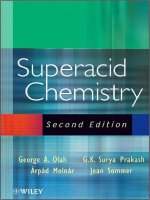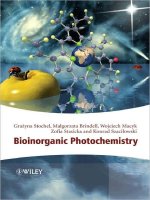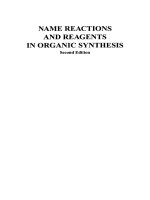olah - superacid chemistry 2e (wiley, 2009)
Bạn đang xem bản rút gọn của tài liệu. Xem và tải ngay bản đầy đủ của tài liệu tại đây (15.94 MB, 867 trang )
SUPERACID CHEMISTRY
SUPERACID CHEMISTRY
SECOND EDITION
George A. Olah
G. K. Surya Prakash
Arp
ad Moln
ar
Jean Sommer
Copyright # 2009 by John Wiley & Sons, Inc. All rights reserved
Published by John Wiley & Sons, Inc., Hoboken, New Jersey
Published simultaneously in Canada
No part of this publication may be reproduced, stored in a retrieval system, or transmitted in any form or by
any means, electronic, mechanical, photocopying, recording, scanning, or otherwise, except as permitted
under Section 107 or 108 of the 1976 United States Copyright Act, without either the prior written
permission of the Publisher, or authorization through payment of the appropriate per-copy fee to the
Copyright Clearance Center, Inc., 222 Rosewood Drive, Danvers, MA 01923, (978) 750-8400, fax (978)
750-4470, or on the web at www.copyright.com. Requests to the Publisher for permission should be
addressed to the Permissions Department, John Wiley & Sons, Inc., 111 River Street, Hoboken, NJ 07030,
(201) 748-6011, fax (201) 748-6008, or online at />Limit of Liability/Disclaimer of Warranty: While the publisher and author have used their best efforts
in preparing this book, they make no representations or warranties with respect to the accuracy or
completeness of the contents of this book and specifically disclaim any implied warranties of
merchantability or fitness for a particular purpose. No warranty may be created or extended by sales
representatives or written sales materials. The advice and strategies contained herein may not be suitable for
your situation. You should consult with a professional where appropriate. Neither the publisher nor
author shall be liable for any loss of profit or any other commercial damages, including but not limited to
special, incidental, consequential, or other damages.
For general information on our other products and services or for technical support, please contact our
Customer Care Department within the United States at (800) 762-2974, outside the United States
at (317) 572-3993 or fax (317) 572-4002.
Wiley also publishes its books in a variety of electronic formats. Some content that appears in print
may not be available in electronic formats. For more information about Wiley products, visit our web site
at www.wiley.com.
Library of Congress Cataloging-in-Publication Data:
Superacid chemistry / by George A. Olah [et al.]. – 2nd ed.
p. cm.
Rev. ed. of : Superacids / George A. Olah, G.K. Surya Prakash, Jean Sommer.
c1985.
Includes index.
ISBN 978-0-471-59668-4 (cloth)
1. Superacids. I. Olah, George A. (George Andrew), 1927- II. Olah,
George A. (George Andrew), 1927- Superacids.
QD477.O53 2009
546
0
.24–dc22
2008026776
Printed in the United States of America
10987654321
In memory of Katherine Bogdanovich Loker, Benefactor and Friend
CONTENTS
Preface to the Second Edition xvii
Preface to the First Edition xix
1. General Aspects 1
1.1. Defining Acidity 1
1.1.1. Acids and Bases 1
1.1.2. The pH Scale 3
1.1.3. Acidity Functions 4
1.2. Definition of Superacids 6
1.2.1. Range of Acidities 7
1.3. Types of Superacids 9
1.3.1. Primary Superacids 10
1.3.2. Binary Superacids 10
1.3.3. Ternary Superacids 10
1.3.4. Solid Superacids 10
1.4. Experimental Techniques for Acidity Measure ments
(Protic Acids) 11
1.4.1. Spectrophotometric Method 11
1.4.2. Nuclear Magnetic Resonance Methods 13
1.4.2.1. Chemical Shift Measurements 15
1.4.2.2. Exchange Rate Measurements Based
on Line-Shape Analysis (DNMR:
Dynamic Nuclear Magnetic Resonance) 18
1.4.3. Electrochemical Methods 20
1.4.4. Chemical Kinetics 20
1.4.5. Heats of Protonation of Weak Ba ses 22
1.4.6. Theoretical Calculations and Superacidity
in the Gas Phase 22
1.4.7. Estimating the Strength of Lewis Acids 23
1.4.8. Experimental Techniques Applied to Solid Acids 27
References 29
vii
2. Superacid Systems 35
2.1. Primary Superacids 35
2.1.1. Brønsted Superacids 35
2.1.1.1 Perchloric Acid 35
2.1.1.2. Chlorosulfuric Acid 36
2.1.1.3. Fluorosulfuric Acid 37
2.1.1.4. Perfluoroalkanesulfonic Acids 38
2.1.1.5. Hydrogen Fluoride 40
2.1.1.6. Carborane Superacids H(CB
11
HR
5
X
6
) 41
2.1.2. Lewis Superacids 42
2.1.2.1. Antimony Pentafluoride 42
2.1.2.2. Arsenic Pentafluoride 44
2.1.2.3. Phosphorus Pentafluoride 44
2.1.2.4. Tantalum and Niobium Pentafluoride 44
2.1.2.5. Boron Trifluoride 44
2.1.2.6. Tris(pentafluorophenyl) Borane 45
2.1.2.7. Boron Tris(trifluoromethanesulfonate) 46
2.1.2.8. Aprotic Organic Superacids
(Vol’pin’s Systems) 46
2.2. Binary Superacids 47
2.2.1. Binary Brønsted Superacids 47
2.2.1.1. Hydrogen Fluoride–Fluorosulfuric Acid 47
2.2.1.2. Hydrogen Fluoride–Trifluoromethanesulfonic
Acid 47
2.2.1.3. Tetra(Hydrogen Sulfato)Boric Acid–Sulfuric
Acid 47
2.2.2. Conjugate Brønsted–Lewis Superacids 47
2.2.2.1. Oleums–Polysulfuric Acids 47
2.2.2.2. Fluorosulfuric Acid–Antimony Pentafluoride
(‘‘Magic Acid’’) 49
2.2.2.3. Fluorosulfuric Acid–Sulfur Trioxide 53
2.2.2.4. HSO
3
F–MF
n
(SO
3
F)
5Àn
;n¼ 3, 4,
M ¼ Nb, Ta 53
2.2.2.5. Fluorosulfuric Acid–Arsenic Pentafluoride 54
2.2.2.6. Perfluoroalkanesulfonic Acid–Based Systems 54
2.2.2.7. Hydrogen Fluoride–Antimony Pentafluoride
(Fluoroantimonic Acid) 56
2.2.2.8. Hydrogen Fluoride– Phosphorus Pentafluoride 59
2.2.2.9. Hydrogen Fluoride–Tanta lum Pentafluoride 60
viii CONTENTS
2.2.2.10. Hydrogen Fluoride–Boron Trifluoride
(Tetrafluoroboric Acid) 60
2.2.2.11. Conjugate Friedel-Crafts Acids (HX–AlX
3
, etc.) 61
2.3. Ternary Superacids 62
2.3.1. HSO
3
F–HF–SbF
5
62
2.3.2. HSO
3
F–HF–CF
3
SO
3
H63
2.3.3. CF
3
SO
3
H–HF–Lewis Acid 63
2.3.4. HSO
3
F–SbF
5
–SO
3
63
2.4. Solid Superacids 63
2.4.1. Zeolitic Acids 64
2.4.2. Polymeric Resin Sulfonic Acids 65
2.4.2.1. Lewis Acid-Complexed Sulfonic Acid Resins 65
2.4.2.2. Perfluorinated Polymer Resin Acids 66
2.4.3. Enhanced Acidity Solids 68
2.4.3.1. Brønsted Acid-Modified Metal Oxides:
TiO
2
–H
2
SO
4
; ZrO
2
–H
2
SO
4
68
2.4.3.2. Lewis Acid-Modified Metal Oxides
and Mixed Oxides 69
2.4.3.3. Lewis Acid-Complexed Metal Salts 70
2.4.4. Immobilized Superacids (Bound to Inert Supports) 71
2.4.4.1. Superacids Immobilized on Solid Supports 71
2.4.4.2. Graphite-Intercalat ed Superacids 72
2.4.4.3. SbF
5
-Fluorinated Graphite,
SbF
5
-Fluorinated Al
2
O
3
74
References 75
3. Carbocations in Superacid Systems 83
3.1. Introduction 83
3.1.1. Development of the Carbocation Concept: Early
Kinetic and Stereochemical Studies 83
3.1.2. Observation of Stable, Long-Lived Carbocations 84
3.1.3. General Concept of Carbocations 85
3.2. Methods of Generating Carbocations in Superacids Systems 87
3.3. Methods and Techniques in the Study of Carbocations 88
3.3.1. Nuclear Magnetic Resonance Spectra in Solution 88
3.3.2.
13
C NMR Chemical Shift Additivity 89
3.3.3. Isotopic Perturbation Technique 90
3.3.4. Solid-State
13
CNMR 90
3.3.5. X-ray Diffraction 91
CONTENTS ix
3.3.6. Tool of Increasing Electron Demand 91
3.3.7. Core Electron Spectroscopy 91
3.3.8. Infrared and Raman Spectroscopy 92
3.3.9. Electronic Spectroscopy 92
3.3.10. Low-Temperature Solution Calorimetric Studies 92
3.3.11. Quantum Mechanical Calculations 93
3.4. Trivalent Carbocations 93
3.4.1. Alkyl Cations 93
3.4.1.1. Early Unsuccessful Attempts 93
3.4.1.2. Preparation from Alkyl Fluorides
in Antimony Pentafluoride Solution
and Spectroscopic Studies 94
3.4.1.3. Preparation from Other Precursors 108
3.4.1.4. Observation in Different Superacids 112
3.4.2. Cycloalkyl Cations 112
3.4.3. Bridgehead Cations 116
3.4.4. Cyclopropylmethyl Cations 120
3.4.5. Alkenyl Cations 123
3.4.6. Alkadienyl and Polyenylic Cations 125
3.4.7. Arenium Ions 126
3.4.8. Ethylenearenium Ions 132
3.4.9. Propargyl and Allenylmethyl Cations
(Mesomeric Vinyl Cations) 134
3.4.10. The Phenyl Cation 139
3.4.11. Arylmethyl and Alkylarylmethyl Cations 140
3.4.12. Carbodications and Polycations 147
3.4.13. Aromatic Stabilized Cations and Dications 157
3.4.14. Polycyclic Arene Dications 162
3.4.15. Fullerene Cations 164
3.4.16. Heteroatom-Stabilized Cations 167
3.4.16.1. Halogen as Heteroatom 167
3.4.16.2. Oxygen as Heteroatom 172
3.4.16.3. Sulfur as Heteroatom 192
3.4.16.4. Nitrogen as Heteroat om 195
3.4.17. Carbocations Complexed to Metal Atoms 204
3.5. Equilibrating (Degenerate) and Higher (Five or Six)
Coordinate (Nonclassical) Carbocations 206
3.5.1. Alkonium Ions (Protonated Alkanes C
n
H
2nþ3
þ
) 206
3.5.1.1. The Methonium Ion (CH
5
þ
) 207
x CONTENTS
3.5.1.2. Multiply Protonated Methane Ions
and Their Analogs 212
3.5.1.3. Varied Methane Cations 214
3.5.1.4. Ethonium Ion (C
2
H
7
þ
) and Analogs 216
3.5.1.5. Proponium Ions and Analogs 218
3.5.1.6. Higher Alkonium Ions 219
3.5.1.7. Adamantonium Ions 224
3.5.2. Equilibrating and Bridged Carbocations 225
3.5.2.1. Degenerate 1,2-Shifts in Carbocations 225
3.5.2.2. The 2-Norbornyl Cation 229
3.5.2.3. The 7-Norbornyl Cation 239
3.5.2.4. The 2-Bicyclo[2.1.1]hexyl Cation 240
3.5.2.5. Degenerate Cyclopropylmethyl and
Cyclobutyl Cations 241
3.5.2.6. Shifts to Distant Carbons 246
3.5.2.7. 9-Barbaralyl (Tricyclo[3.3.1.0
2,8
]nona-3,
6-dien-9-yl) Cations and Bicyclo[3.2.2]
nona-3,6,8-trien-2-yl Cations 253
3.5.2.8. The 1,3,5,7-Tetramethyl- and 1,2,3,5,
7-Pentamethyl-2-ad amantyl Cations 257
3.5.3. Homoaromatic Cations 258
3.5.3.1. Monohomoaromatic Cations 259
3.5.3.2. Bishomoaromatic Cations 260
3.5.3.3. Trishomoaromatic Cation s 265
3.5.3.4. Three-Dimensional Homoaromaticity 266
3.5.4. Pyramidal Cations 267
3.5.4.1. (CH)
5
þ
-Type Cations 267
3.5.4.2. (CH)
6
2
þ
-Type Dications 270
References 273
4. Heterocations in Superacid Systems 311
4.1. Introduction 311
4.2. Onium Ions 311
4.2.1. Oxonium Ions 311
4.2.1.1. Hydronium Ion (H
3
O
þ
) 311
4.2.1.2. Primary Oxonium Ions [ROH
2
þ
] 313
4.2.1.3. Secondary Oxonium Ions [RR
0
OH
þ
] 319
4.2.1.4. Tertiary Oxonium Ions 322
4.2.1.5. Aurated Oxonium Ions 328
CONTENTS xi
4.2.1.6. Hydrogen Peroxonium Ion (H
3
O
2
þ
)
and Derivatives 329
4.2.1.7. Ozonium Ion (HO
3
þ
) 330
4.2.2. Sulfonium Ions 331
4.2.2.1. Hydrosulfonium Ion (H
3
S
þ
) 331
4.2.2.2. Primary Sulfonium Ions 332
4.2.2.3. Secondary Sulfonium Ions 334
4.2.2.4. Tertiary Alkyl(Aryl)Sulfonium Ions 335
4.2.2.5. Halosulfonium Ions 340
4.2.2.6. Sulfonium Ions with Other Heteroligands 342
4.2.3. Selenonium and Telluronium Ions 350
4.2.3.1. Hydridoselenonium and Hydridotelluronium Ions 350
4.2.3.2. Acidic Selenonium and Telluronium Ions 351
4.2.3.3. Tertiary Selenonium and Telluronium Ions 352
4.2.3.4. Haloselenonium and Halotelluronium Ions 356
4.2.3.5. Aurated Selenonium and Telluronium Ions 357
4.2.3.6. Polychalcogen Dications 358
4.2.4. Halonium Ions 360
4.2.4.1. Acyclic (Open-Chain) Haloniu m Ions 362
4.2.4.2. Cyclic Halonium Ions 372
4.2.5. Onium Ions of Group 15 Elements 381
4.2.5.1. 2-Azoniaallene and Derived Cations 381
4.2.5.2. Diazonium Ions 383
4.2.5.3. Nitronium Ion (NO
2
þ
) 390
4.2.5.4. Nitrosonium Ion (NO
þ
) 392
4.2.5.5. Ammonium, Phosphonium, Arsonium,
and Stibonium Ions 394
4.3. Enium Ions 397
4.3.1. Enium Ions of Group 13 Elements 397
4.3.1.1. Borenium Ions 397
4.3.1.2. Alumenium Ions 400
4.3.2. Enium Ions of Group 14 Elements 401
4.3.2.1. Silicenium Ions 401
4.3.2.2. Germenium Ions 411
4.3.2.3. Enium Ions of Other Group 14 Elements 413
4.3.3. Enium Ions of Group 15 Elements 415
4.3.3.1. Nitrenium Ions 415
4.3.3.2. Phosphenium Ions 417
4.3.3.3. Enium Ions of Other Group 15 Elements 423
xii CONTENTS
4.3.4. Enium Ions of Group 16 Elements 424
4.3.4.1. Oxenium Ions 424
4.3.4.2. Enium Ions of Other Group 16 Elements 425
4.4. Homo- and Heteropolyatomic Cations 426
4.4.1. Halogen Cations 427
4.4.1.1. Iodine Cations 427
4.4.1.2. Bromine Cations 430
4.4.1.3. Chlorine Cations 432
4.4.2. Interhalogen Cations 433
4.4.2.1. Triatomic Interhalogen Cations 433
4.4.2.2. Pentaatomic Interhalogen Cations 436
4.4.2.3. Heptaatomic Interhalogen Cations 437
4.4.3. Polyatomic Cations of Group 16 Elements 438
4.4.3.1. The O
2
þ
Cation 438
4.4.3.2. Polysulfur Cations 439
4.4.3.3. Polyselenium Cations 441
4.4.3.4. Polytellurium Cations 444
4.4.3.5. Polyheteroatom Cations 445
4.4.4. Mixed Polyheteroatom Cations of Group 15, 16,
and 17 Elements 447
4.4.4.1. Polyheteroatom Cations of Nitrogen and Sulfur 447
4.4.4.2. Polyheteroatom Cations of Halogens
with Oxygen or Nitrogen 448
4.4.4.3. Polyheteroatom Cations of Chalcogens
with Halogens 450
4.5. Cations of Group 6–12 Elements 453
4.5.1. Homoleptic Metal Carbonyl Cations 453
4.5.2. Other Cations of Group 6–12 Elements 456
4.6. Miscellaneous Cations 460
4.6.1. Hydrogen Cations 460
4.6.1.1. H
þ
Ion 460
4.6.1.2. H
3
þ
Ion 460
4.6.2. Cations of Noble Gases 460
References 465
5. Superacid-Catalyzed Reactions 501
5.1. Conversion of Saturated Hydrocarbons 501
5.1.1. Sigma-Basicity: Reversible Protonation or Protolysis
of C–H and C–C Bond 503
CONTENTS xiii
5.1.1.1. Deuterium–Hydr ogen Exchange Studies 505
5.1.2. Electrochemical Oxidation in Strong Acids 520
5.1.3. Isomerization of Alkanes 524
5.1.4. Cleavage Reactions (b-Cleavage versus C–C Bond
Protolysis) 539
5.1.5. Alkylation of Alkanes and Oligocondensation
of Lower Alkanes 543
5.2. Alkylation of Aromatic Hydrocarbons 554
5.2.1. Alkylation with Alkenes 554
5.2.2. Alkylation with Alcohols and Cyclic Ethers 560
5.2.3. Alkylation with Alkyl Halides 566
5.2.4. Alkylation with Carbonyl Compounds and Derivatives 577
5.2.5. Alkylation with Acid Derivatives 585
5.2.6. Isomerization and Transalkylation of Alkylbenzenes 586
5.2.7. Alkylation with Miscellaneous Reagents 589
5.2.8. Cyclialkylation 595
5.3. Acylation of Aromatics 608
5.4. Carboxylation 618
5.5. Formylation 627
5.6. Thio- and Dithiocarboxylation 632
5.7. Sulfonation and Sulfonylation 633
5.8. Nitration 636
5.9. Nitrosonium Ion (NO
þ
)-Induced Reactions 643
5.10. Halogenation 647
5.10.1. Halogenation of Nonaromatic Compounds 647
5.10.2. Halogenation of Aromatic Compounds 655
5.11. Amination 659
5.12. Oxyfunctionalization 660
5.12.1. Oxygenation with Hydrogen Peroxide 661
5.12.1.1. Oxygenation of Alkanes 661
5.12.1.2. Oxygenation of Aroma tics 663
5.12.1.3. Oxygenation of Natural Products 666
5.12.2. Oxygenation with Ozone 667
5.12.3. Oxygenation Induced by Nafion Resins 672
5.12.4. Oxygenation by Other Methods 674
5.13. Superacids in Protection Group Chemistry 676
5.14. Superacids in Heterocyclic Chemistry 680
5.14.1. Synthesis of Heterocycles 680
5.14.1.1. Preparation of Oxacycloalkanes 680
xiv CONTENTS
5.14.1.2. Synthesis of Nitrogen Heterocycles 685
5.14.1.3. Heterocycles with Two or Three Heteroatoms 689
5.14.2. Ring-Opening of Oxygen Heterocycles 696
5.15. Dehydration 698
5.16. Superacids in Carbohydrate Chemistry 700
5.17. Rearrangements and Cyclizat ions 706
5.17.1. Rearrangements and Cyclizations of Natural Products 706
5.17.2. Phenol–Dienone Rearrangements 722
5.17.3. Other Rearrangements and Cyclizations 724
5.18. Ionic Hydrogenation 727
5.19. Esterification and Ester Cleavage 734
5.20. Additions 735
5.20.1. Cycloadditions 735
5.20.2. Other Additions 738
5.21. Ritter Reactions 742
5.22. Polymerization 744
5.23. Miscellaneous Reactions 750
References 756
Outlook 789
Index 791
CONTENTS xv
PREFACE TO THE SECOND EXTENDED
AND UPDATED EDITION
More than 20 years passed since the publication of our book on Superacids. The book
became out of print and much progress since was made in the field, which is gaining
increasing interest and significance. Hence, it seems warranted to provide the
interested reader with a comprehensively updated review and discussion of the field
with literature coverage until early 2008. The title has been changed to ‘‘Superacid
Chemistry” to reflect enormous progress in the field. Some aspects of superelec-
trophilic activation are also discussed (for more elaborate coverage, readers are
referred to G. A. Olah and D. A. Klump, ‘‘Superelectrophiles and Their Chemistry”
Wiley-Interscience, 2008). Our friend and colleague,
Arp
ad Moln
ar joined us as a
coauthor and made an outstanding contribution to the revised new edition of our book,
which we hope will be of interest and use to the chemical community. Our publisher is
thanked for arranging the new revised edition.
G
EORGE A. OLAH
Los Angeles, California
G. K. S
URYA PRAKASH
Los Angeles, California
A
RP
AD MOLN
AR
Szeged, Hungary
J
EAN SOMMER
Strasbourg, France
October 2008
xvii
PREFACE TO THE FIRST EDITION
The chemistry of superacids, that is, of acid systems stronger than conventional
strong mineral Brønsted acids such as sulfuric acid or Lewis acids like aluminum
trichloride, has developed in the last two decades into a field of growing interest and
importance. It was J. B. Conant who in 1927 gave the name “superacids” to acids that
were capable of protonating certain weak bases such as carbonyl compounds and
called attention to acid systems stronger than conventional mineral acids. The
realization that Friedel–Crafts reactions are, in general, acid catalyzed with conjugate
Lewis–Brøns ted acid systems frequently acting as the de facto catalysts extended the
scope of acid catalyzed reactions. Friedel–Crafts acid systems, however, are usually
only 10
3
to 10
6
times stronger than 100% sulfuric acid. The development in the early
1960s of Mag ic Acid, fluoroantimonic acid, and related conjugate superacids, 10
7
to
10
10
times stronger than sulfuric acid, added a n ew dimensio n to and revival of
interest in superacids and their chemistry. The initial impetus was given by the
discovery that stable, long-lived, electron-deficient cations, such as carbocations,
acidic oxonium ions, halonium ions, and halogen cations, can be obtained in these
highly acidic systems. Subseque nt work opened up new vistas of chemistry and a
fascinating, broad field of chemistry is developing at superacidities. Because acidity
is a term related to a reference base, superacidity a llows extension of acid-catalyzed
reactions to very weak bases and thus extends, for example, hydrocarbon chemistry to
saturated systems including methane.
Some years ago in two review articles (Science 206, 13, 1979; La Recherche 10,
624, 1979), we briefly reviewed some of the emerging novel aspects of superacids.
However, we soon realized that the field was growing so fast that to be able to provide a
more detailed survey for the interested chemist a more comprehensive review was
required. Hence, we welcomed the suggestion of our publisher and Dr. Theodore P.
Hoffman, chemistry editor of Wiley-Interscience, that we write a monograph on
superacids.
We are unable to thank all of our friends and colleagues who directly or indirectly
contributed to the development of the chemistry of superacids. The main credit goes to
all researchers in the field whose work created and continues to enrich this fascinating
area of chemistry. Professor R. J. Gillespie’s pioneering work on the inorganic
chemistry of superacids was of immense value and inspiration to the development
of the whole field. Our specific thanks are due to Drs. David Meidar and Khosrow
Laali, who helped with the review of solid superacid systems and their reactions.
Professor E. M. Arnett is thanked for reading part of our manuscript and for his
thoughtful comments.
xix
Finally we would like to thank Mrs. R. Choy, who tirelessly and always cheerfully
typed the manuscript.
G
EORGE A. OLAH
Los Angeles, California
G. K. S
URYA PRAKASH
Los Angeles, California
J
EAN SOMMER
Strasbourg, France
xx PREFACE TO THE FIRST EDITION
CHAPTER 1
General Aspects
1.1. DEFINING ACIDITY
1.1.1. Acids and Bases
The concept of acidity was born in ancient times to describe the physiological property
such as taste of food or beverage (in Latin: acidus, sour; acetum, vinegar). Later during
the development of experimental chemistry, it was soon realized that mineral acids
such as sulfuric, nitric, and hydrochloric acids played a key role in chemical
transformations. Our present understanding of aci d-induced or -catalyzed reactions
covers an extremely broad field ranging from large-scale industrial processes in
hydrocarbon chemistry to enzyme-controlled reactions in the living cell.
The chemical species that plays a unique and privileged role in acidity is the
hydrogen nucleus, that is, the proton: H
þ
. Since its 1s orbital is empty, the proton is not
prone to electronic repulsion and by itself has a powerful polarizing effect. Due to its
very strong electron affinity, it cannot be found as a free “naked” species in the
condensed state but is always associated with one or more molecules of the acid itself
or of the solvent. Free protons exist only in the gas phase (such as in mass spectrometric
studies). Regardless, as a shorthand notation, one generally depicts the proton in
solution chemistry as “H
þ
.” Due to its very small size (10
5
times smaller than any other
cation) and the fact that only the 1s orbital is used in bonding by hydrogen, proton
transfer is a very facile chemical reaction and does not necessitate important
reorganization of the electronic valence shells. Understanding the nature of the proton
is important while generalizing quantitative relationships in acidity measurem ents.
1,2
The first clear definition of acidity can be attributed to Arrhenius, who between
1880 and 1890 elaborated the theory of ionic dissociation in water to explain the
variation in strength of different acids.
3
Based on electrolytic experiments such as
conductance measurements, he defined acids as substances that dissociate in water and
yield the hydrogen ion whereas bases dissociate to yield hydroxide ions. In 1923, J. N.
Brønsted generalized this concept to other solvents.
4
He defined an acid as a species
that can donate a proton and defined a base as a species that can accept it. This
Superacid Chemistry, Second Edition, George A. Olah, G. K. Surya Prakash,
Arp
ad Moln
ar, and Jean Sommer
Copyright Ó 2009 John Wiley & Sons, Inc.
1
definition is generally known as the Brønsted–Lowry concept. The dissociation of an
acid HA in a solvent S can be written as an acid–base equilibrium [Eq. (1.1)].
HA + S A
−
+ SH
+
ð1:1Þ
The ionization of the acid HA in solvent S leads to a new acid HS
þ
and a base A
À
.
Equation (1.1) has a very wide scope and can be very well applied to neutral and
positively and negatively charged acid systems. The acid–base pair that differs only by
a proton is referred to as the conjugate acid–base pair. Thus, H
2
O is the conjugate base
of the acid H
3
O
þ
. An obvious consequence of the concept is that the extent to which an
acid ionizes depends on the basicity of the solvent in which the ionization takes place.
This shows the difficulty in establishing an absolute acidity scale. Acidity scales are
energy scales, and thus they are arbitrary with respect to both the reference point and
the magnitude of units chosen.
Fortunately, many of the common solvents by themselves are capable of acting
as acids and bases. These amphoteric or amphiprotic solvents undergo self-ionization
[e.g., Eqs. (1.2) and (1.3)], which can be formulated in a general way as in Eq. (1.4).
2 H
2
O H
3
O
+
+ OH
−
ð1:2Þ
2 HF H
2
F
+
+ F
−
ð1:3Þ
2 HA H
2
A
+
+ A
−
ð1:4Þ
This equilibrium is characterized by the autoprotolysis constant K
ap
, which under
the usual high dilution conditions can be written as in Eq. (1.5).
K
ap
¼½H
2
A
þ
½A
À
ð1:5Þ
Indeed the extent of dissociation of the solvent is very small (in HF, K
ap
% 10 –11;
in H
2
O, K
ap
¼ 10 –14). The pK
ap
value that gives the acidity range will be discussed
later.
G.N. Lewis extended and generalized the acid–base concept to nonprotonic
systems.
5,6
He defined an acid as a substance that can accept electrons and defined a
base as a substan ce that can donate el ectr ons. Lewis acids are electron-deficient
moleculesorionssuchasBF
3
or carbocations, whereas Lewis bases are molecules
that contain readily available nonbonded electron pairs (as in ethers, amines, etc.)
[Eq. (1.6)].
BF
3
+ :O(CH
3
)
2
BF
3
:O(CH
3
)
2
ð1:6Þ
Of course, in a generalized way, the proton H
þ
is also a Lewis acid and the Brønsted
acids and bases also fall into the Lewis categories.
Considering the general equation (1.4) for the auto-ionization of solvent HA, one
can define an acid as any substance that will increase [H
2
A
þ
] and define a base as any
substance that will increase [A
À
] and thus decrease [H
2
A
þ
]. This definition, which
includes both Lewis’ and Brønsted’s concepts, is used in practice while measuring the
acidity of a solution by pH.
2 GENERAL ASPECTS
A number of strategies have been developed for acidity measurements of both
aqueous and nonaqueous solutions. We will briefly review the most important ones and
discuss their use in establishing acidity scales.
1.1.2. The pH Scale
The concentration of the acid itself is of little significance other than analytical, with
the exception of strong acids in dilute aqueous solutions. The concentration of H
þ
itself is not satisfactory either, because it is solvated diversely and the ability of
transferring a proton to another base depends on the nature of the medium. The real
physical quantity describing the acidity of a medium is the activity of the proton a
H
þ
.
The experimental determination of the activity of the proton requires the measurement
of the potential of a hydrogen electrode or a glass electrode in equilibrium with the
solution to be tested. The equation is of the following type [Eq. (1.7)], wherein C is a
constant.
E ¼ CÀ
RT
F
log
10
ða
H
þ
Þð1:7Þ
It was Sørensen’s i dea
7
to use this relationship, which c an be considered as a basis
to the modern d efinition of the pH scale of acidity for aqueous solutions. The pH of
a dilute solution of a cid is related to the concentration o f the solvated proton from
Eq. (1.8). Depending on the dilution, the proton can be further solvated by two or
more solvent m olecules.
pH ¼Àlog½HS
þ
ð1:8Þ
When the acid solution is highly diluted in water, the pH measurement is
convenient, but it becomes critical when the acid concentration increases and, even
more so, if nonaqueous media are employed. Since a reference cell is used with a liquid
junction, the potential at the liquid junction also has to be known. The hydrogen ion
activity cannot be measured independently, and for this reason the equality of Eq. (1.9)
cannot be definitely established for any solution.
pH ¼Àlog
10
ða
H
þ
Þð1:9Þ
Under the best experimental conditions, the National Bureau of Standard has set up
a series of standard solutions of pH from which the pH of any other aqueous solution
can be extrapolated as long as the ionic strength of the solution is not higher than 0.1 M.
For more concentrated solutions, the pH scale will no longer have any real signifi-
cance. In extending the limit to 1 M solutions, it is apparent that the available range
of acidity is directly related to the autoprotolysis constant [Eq. (1.5)], because the
minimum value of pH in a solution is zero and the maximum value is pK
ap
¼
p(H
2
A
þ
) þ p(A
À
). Thus, the range of pH (DpH) is pK
ap
(for water, 14 pH units). These
limiting conditions are rather unfortunate because many chemical transformations are
achieved beyond this range and under much less ideal conditions.
DEFINING ACIDITY 3
1.1.3. Acidity Functions
Considering the limited applicability of the pH scale, a quantitative scale is needed to
express the acidity of more concentrated or nonaqueous solutions.
A knowledge of the acidity parameter should permit one to estimate the degree of
transformation of a given base (to its protonated form) in its conjugate acid. This
should allow one to relate these data to the rate of acid-catalyzed reactions. Hammett
and Deyrup
8
in 1932 were the first to suggest a method for measuring the degree of
protonation of weakly basic indicators in acid solution. The proton transfer equilibri-
um in the acid solution between an electro-neutral weak base B and the solvated proton
can be written as in Eq. (1.10).
B + H
2
A
+
BH
+
+ AH
ð1:10Þ
Bearing in mind that the proton is solvated (AH
2
þ
) and that AH is the solvent, the
equilibrium can be written as in Eq. (1.11).
B + H
+
BH
+
ð1:11Þ
The corresponding thermodynamic equilibrium constant is K
BH
þ
, which is
expressed as in Eq. (1.12), in which a is the activity, C the concentration, and f the
activity coefficient.
K
BH
þ
¼
a
H
þ
Áa
B
a
BH
þ
¼
a
H
þ
ÁC
B
C
BH
þ
Á
f
H
f
BH
þ
ð1:12Þ
From this equation, Eq. (1.13) follows.
C
BH
þ
C
B
¼
1
K
BH
þ
Áa
H
þ
Á
f
B
f
BH
þ
ð1:13Þ
Because the first ratio represents the degree of protonation, Hammett and Deyrup
8,9
defined the acidity function H
0
by Eq. (1.14).
H
0
¼Àloga
H
þ
Á
f
B
f
BH
þ
¼ÀlogK
BH
þ
þ log
C
B
C
BH
þ
ð1:14Þ
Equation (1.14) can be written for further discussion in the more usual form of
Eq. (1.15).
H
0
¼ pK
BH
þ
Àlog
½BH
þ
½B
ð1:15Þ
From Eq. (1.14) it is clear that in dilute aqueous solution, as the activity coefficients
tend to unity, the Hammett acidity function becomes identical with pH. On the other
hand, by making the fundamental assumption that the ratio f
B
=f
BH
þ
is the same for
different bases in a given solution, Hammett postulated that the H
0
function was unique
4 GENERAL ASPECTS
for a particular series of solutions of changing acidity. The first application was made
for the H
2
SO
4
–H
2
O system using a series of primary anilines as indicators. By starting
with the strongest base B
1
, the pK
B
1
H
þ
was measured in dilute aqueous solution. The
pKof the next weaker base B
2
was then determined by measuring the ionization ratio of
the two indicators in the same acid solution using the relation of Eq. (1.16).
pK
B
1
H
þ
ÀpK
B
2
H
þ
¼ log
½B
1
H
þ
½B
1
Àlog
½B
2
H
þ
½B
2
ð1:16Þ
The ionization ratio was measured by UV–visible spectroscopy. With the help of
successively weaker primary aromatic amine indicators, the strongest base being
para-nitroaniline (pK ¼ 1.40) and the weakest trinitroaniline (pK ¼À9), Hammett
explored the whole H
2
O–H
2
SO
4
range up to 100% sulfuric acid and the perchloric
acid–water solution up to 60% of acid. Similar acidity functions such as H
À
,H
þ
,H
2þ
were proposed related to acid–base equilibria in which the indicator is negatively,
positively, or even dipositively charged. The validity of all of these functions is based
on the simple assumption that the activity coefficient ratio is independent of the nature
of the indicator at any given solvent composition. In this case the log [BH
þ
]/[B] plots
against H
0
should be linear with a slope of À1.00 for all neutral bases. This is not the
case for groups of indicators with different structures, and especially for different basic
sites, which often show significant deviations. For this reason, it is well recognized
now that the above assumption does not have a general validity. The measurement of a
Hammett acidity function should be limited to those indicators for which log [BH
þ
]/
[B] plotted against H
0
gives a straight line with a negative unit slope. These indicators
are called Hammett bases.
Equilibria other than proton transfer have also been used to determine acidity
functions. One of these is based on the ionization of alcohols (mainly arylmethyl
alcohols) in acid solution following the equilibrium in Eq. (1.17).
ROH + H
+
R
+
+ H
2
O
ð1:17Þ
The corresponding acidity function described as H
R
is then written in Eq. (1.18).
H
R
¼ pK
R
þ
Àlog
½R
þ
½ROH
ð1:18Þ
This H
R
function, also called J
0
function, has also been used to measure the acidity
of the sulfuric acid–water and perchloric acid–water systems. It shows a large
deviation from the H
0
scale in the highly concentrated solutions as shown in Figure 1.1.
However, all these and other acidity functions are based on Hamm ett’s principle
and can be expressed by Eq . (1.19), in which B and A are the basic and the conjugate
acidic form o f the indicator, respectively. They become identical with the pH scale in
highly dilute acid solutions. The relative and absolute validity of the different acidity
functions have been the subject of much controversy and the subject has been
extensively reviewed.
1,10–14
DEFINING ACIDITY 5
H
x
¼ pK
A
À log
A
B
ð1:19Þ
Whatever may be the limitations of the concept first proposed by Hammett and
Deyrup in 1932
8
until now, no other widely used alternative has appeared to better
assess quant itatively the acidity of concentrated and nonaqueous strongly acidic
solutions.
9
The experimental methods that have been used to determine acidity
functions are discussed in Section 1.4.
1.2. DEFINITION OF SUPERACIDS
It was in a paper (including its title) published in 1927 by Hall and Conant
15
in the
Journal of the American Chemical Society that the name “superacid” appeared for the
first time in the chemical literature. In a study of the hydrogen ion activity in a
nonaqueous acid solution, these authors noticed that sulfuric acid and perchloric acid
in glacial acetic acid were able to form salts with a variety of weak bases such as
ketones and other carbonyl compounds. These weak bases did not form salts with the
aqueous solutions of the same acids. The authors ascribed this high acidity to the
ionization of these acids in glacial acetic acid, increasing the concentration of
CH
3
COOH
2
þ
, a species less solvated than H
3
O
þ
in the aqueous acids. They proposed
0
5
10
100500
mole % acid
-H
0
, -J
0
J
0
H
0
Figure 1.1. H
0
and J
0
functions for H
2
SO
4
–H
2
O and HClO
4
–H
2
O systems. HClO
4
: *, ref. 11;
*, ref. 13; H
2
SO
4
: &, ref. 12; &, ref. 14.
6
GENERAL ASPECTS
to call these solutions “superacid solutions.” Their proposal was, however, not further
followed up or used until the 1960s, when Olah’s studies of obtaining stable solutions
of highly electron-deficient ions, particularly carb ocations, focused interest on very
high-acidity nonaqueous systems.
16,17
Subsequently, Gillespie proposed an arbitrary
but since widel y accepted definition of superacids,
18,19
defining them as any acid
system that is stronger than 100% sulfuric acid, that is, H
0
À12. Fluorosulfuric acid
and trifluoromethanesulfonic acid are examples of Brønsted acids that exceed the
acidity of sulfuric acid with H
0
values of about À15.1 and À14.1, respectively.
To reach acidities beyond this limit, one has to start with an already strong acid
(H
0
%À10) and add to it a stronger acid that increases the ionization. This can be
achieved either by adding a strong Brønsted acid (HB) capable of ionizing in the
medium [Eq. (1.20)] or by adding a strong Lewis acid (L) that, by forming a conjugate
acid, will shift the autoprotonation equilibrium by forming a more delocalized
counterion of the strong acid [Eq. (1.21)].
HA + HB H
2
A
+
+ B
−
ð1:20Þ
2 HA + L H
2
A
+
+ LA
−
ð1:21Þ
In both cases, a remarkable acidity increase is observed from the H
0
value of the
neat HA as shown in Figure 1.2 for HSO
3
F.
It is this large acidity jump, generally more than 5 H
0
units, that raises a strong acid
solution into the superacid region. Therefore, it is clear that the proposed reference of
H
0
¼À12 for the lower limit of superacidity is only arbitrary. It could as well be
H
0
¼À15.1 with HF or HSO
3
F as solvent.
Gillespie’s definition of superacids relates to Brønsted acid systems. Because
Lewis acids also cover a wide range of acidities extending beyond the strength of
conventionally used systems, Olah suggested the use of anhydrous aluminum chloride
as the arbitrary reference and we categorize Lewis superacids as those stronger than
aluminum chloride
17
(see, however, subsequent discussion on the difficulties of
measuring the strength of a Lewis acid).
It should be also noted that in biological chemistry, following a suggestion by
Westheimer,
20
it is customary to call catalysis by metal ions bound to enzyme systems
as “superacid catalysis.” Because the role of a metal ion is analogous to a proton, this
arbitrary suggestion reflects enhanced activity and is in line with previously discussed
Brønsted and Lewis superacids.
1.2.1. Range of Acidities
Despite the fact that superacids are stronger than 100% sulfuric acid, there may be as
much or more difference in acidity between various superacid systems than between
neat sulfuric acid and its 0.1 M solution in water.
Acidity levels as high as H
0
¼À27 have been estimated on the basis of exchange
rate measurements by NMR for an HSO
3
F–SbF
5
mixture cont aining 90 mol% SbF
5
.
21
In fact, the HF–SbF
5
is considered one of the strongest superacid system based on
DEFINITION OF SUPERACIDS 7
various measurements. Meanwhile, however, Sommer and coworkers found that the
weakest basic indicator of the para-methoxybenzhydryl cation family (4,4’-
dimethoxy; pK
BH
þ
$À23) could not be diprotonated even in the strongest HF–SbF
5
acid.
22
For this reason it appears that one should not expect acidity levels higher than
approximately H
0
¼À24 in the usual superacid systems (Figure 1.3). Predictions of
stronger acidities are all based on indirect estimations rather than direct acid–base
equilibria measurements. It is important to recognize that the naked proton “H
þ
” is not
present in the condensed phase because even compounds as weakly basic as methane
or even rare gases bind the proton.
23,24
A quantitative determination of the strength of Lewis acids to establish similar
scales (H
0
) as discussed in the case of protic (Brønsted-type) superacids would be most
useful. However, to establish such a scale is extremely difficult. Whereas the Brønsted
acid–base interaction invariably involves a proton transfer reaction that allows
meaningful comparison, in the Lewis acid–base interaction, involving for example
Lewis acids with widely different electronic and steric donating substituents, there is
no such common denominator.
25,26
Hence despite various attempts, the term “strength
of Lewis acid” has no well-defined meaning.
13.2
14.2
15.2
16.2
-H
0
SO
3
AsF
5
H
2
SO
4
SbF
5
KSO
3
F
H
0
calc.
mole % base mole % acid
2 100% 2 4 6 8 10
Figure 1.2. Acidity increase near the H
0
value of neat HSO
3
F.
19
8 GENERAL ASPECTS









